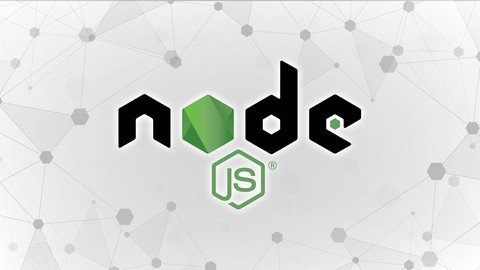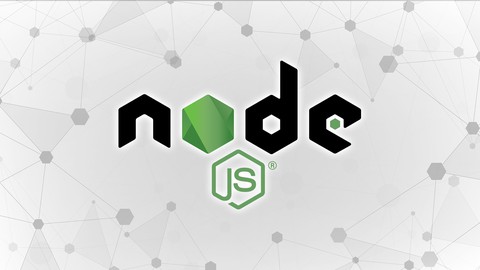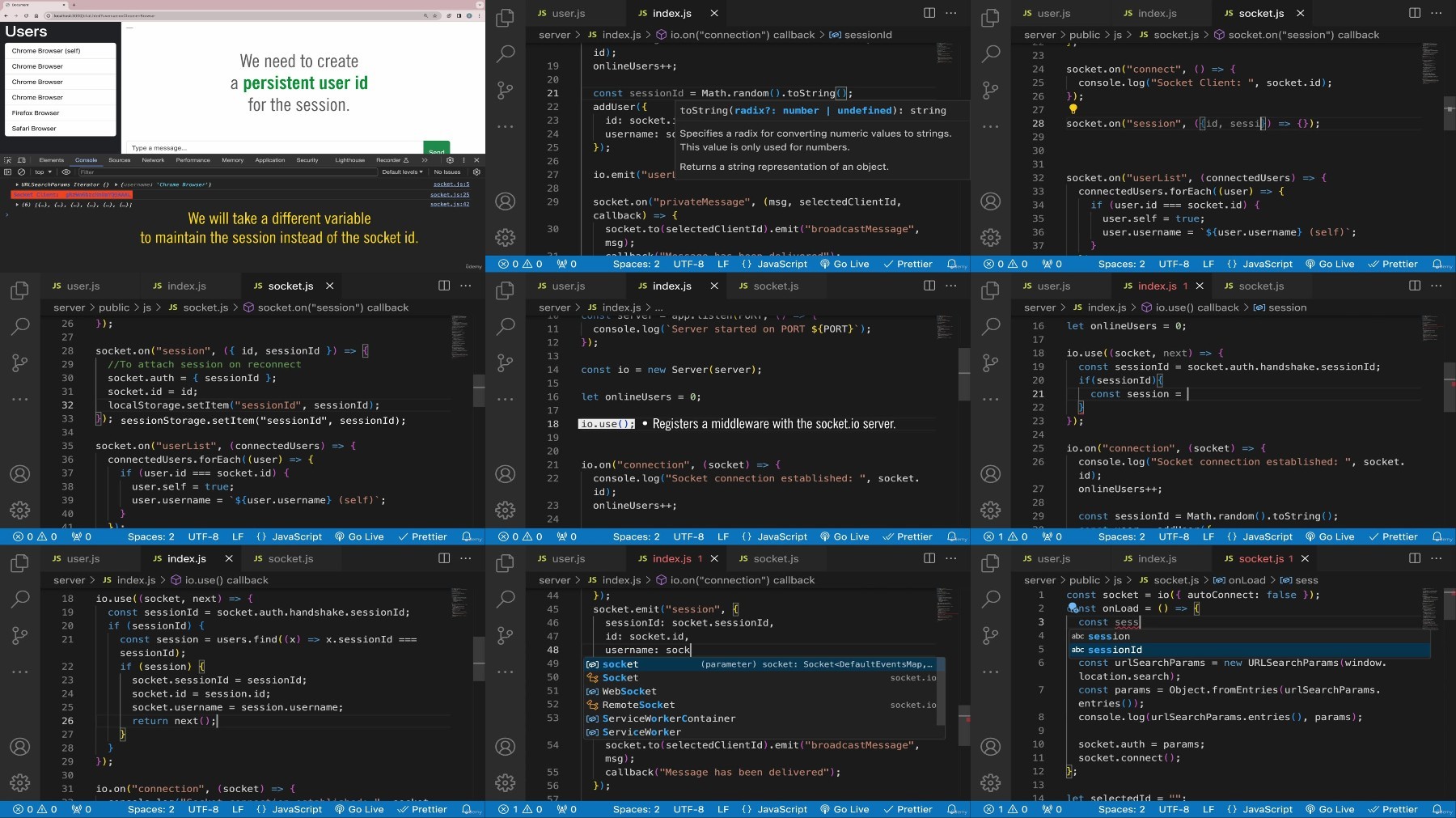
Free Download Mastering Nodejs With Interview Questions 2024
Published 12/2023
MP4 | Video: h264, 1920x1080 | Audio: AAC, 44.1 KHz
Language: English | Size: 2.91 GB | Duration: 6h 24m
Learn Express.js, REST API, MySQL, Sequelize, MongoDB, Mongoose, Handlebars, EJS, SocketIO, JWT, BcryptJS and more.
What you'll learn
Gain a solid understanding of NodeJS fundamentals.
Build robust web applications and REST APIs using ExpressJS.
Using middleware and routing for seamless API development.
Front-end designing using Templating engine (Handlebars and EJS).
Explore database integration, mastering CRUD operations for effective data handling.
Enhance your debugging skills with advanced techniques.
Apply knowledge through practical projects, reinforcing skills and ensuring a real-world understanding.
Ace NodeJS interviews with hands-on practice.
Build a strong foundation for a server-side developer role.
Requirements
Basic HTML, CSS & JavaScript knowledge, but it isn't mandatory!
Time, attention and dedication to learn & practice.
Description
Key concepts covered:Node BasicsBuffersFile System ObjectHTTP ModuleExpress.jsMiddlewareTemplating Engine (Pug, Handlebars & EJS)Working with MySQLSequelizeREST APIsCookiesSessionLocal StorageJWTBcryptJSWorking with MongoDBMongoosePaginationEmailFile Upload/DownloadSocketIOTestingDeploymentPractical assignments & more...Explore the dynamic universe of server-side web development with this meticulously crafted Node.js course, tailored for both aspiring learners and seasoned professionals looking to master server-side JavaScript. This progressive guide takes you on a hands-on exploration of Node.js, the powerhouse behind scalable and efficient web applications.In this course, you'll learn the correct approach to tackle real-world projects - ensuring that you gain practical skills that are directly applicable in professional settings.Adding to that, I'll equip you with a curated collection of interview questions, preparing you to confidently navigate Node.js technical assessments.Here are the key features of this course:Master Node.js Fundamentals → Grasp the foundational principles of Node.js.Express.js and API Development Skills → Master middleware techniques for building robust web applications and APIs.Interview-Ready Confidence → Real-world interview preparation, ensuring confidence in tackling Node.js technical assessments.Effective Database Integration → Seamless database integration, mastering CRUD operations and scalability strategies for optimal application performance.I'll keep you in the loop on what's next for Node.js to be always ahead of the game with insights into the future of this tech powerhouse.Enroll today and take a definitive step towards shaping a successful career in the world of server-side web development.
Overview
Section 1: Introduction
Lecture 1 Installation and Environment Setup
Lecture 2 Initializing Project using NPM
Lecture 3 What is Node,js?
Section 2: Node Basics
Lecture 4 First Application
Lecture 5 Introduction to Modules
Lecture 6 Exporting Object Literal - Multiple Exports
Lecture 7 Basic Debugging
Lecture 8 Global Objects
Lecture 9 setTimeout() - Global object Method
Lecture 10 clearTimeout() - Global object Method
Lecture 11 setInterval() - Global Object Method
Lecture 12 clearInterval() - Global Object Method
Lecture 13 The "process" Global Object
Lecture 14 Process.argv
Lecture 15 "process.on()" - Process Event Handling
Lecture 16 Chalk library
Lecture 17 OS Module
Lecture 18 What is REPL?
Lecture 19 Event Loop
Section 3: Buffers
Lecture 20 Introduction to Buffers
Lecture 21 Numeric Systems
Lecture 22 Character sets - Unicode
Lecture 23 Working with Buffers
Lecture 24 Buffer.from()
Lecture 25 Changing Buffer Values
Section 4: File System Object
Lecture 26 What is File System Object?
Lecture 27 Does it Exist? - fs.existsSync()
Lecture 28 Reading Files With 'fs' Object
Lecture 29 Writing Files - writeFile()
Lecture 30 readFile() vs readFileSync()
Lecture 31 fs.copyFile()
Lecture 32 Assignment - Copy Any File to a Given Location
Lecture 33 fs.appendFile()
Lecture 34 Reading Directory Using "readdir()"
Lecture 35 Assignment - Count files & folders of directory
Lecture 36 Renaming and moving Files - fs.rename()
Lecture 37 Deleting a File - fs.unlink()
Lecture 38 readdir() Vs readdirSync()
Lecture 39 Creating Folder using fs.mkdir()
Lecture 40 Delete Folder - fs.rmdir() & recursive
Section 5: HTTP Module
Lecture 41 Introduction - What is a server?
Lecture 42 Creating Server with "http"
Lecture 43 Decoding "The Request" object
Lecture 44 Auto Restart Server - "Nodemon"
Lecture 45 Responding to request - Response object
Lecture 46 Routes - Request.url
Lecture 47 Sending JSON Response
Lecture 48 Assignment - Get Server Date & Time
Lecture 49 , Query String - GET method
Lecture 50 Request with POST method
Lecture 51 POST-ing Data
Lecture 52 "querystring" - Parsing
Lecture 53 Assignment - POST data to a JSON file on server
Section 6: Express.js
Lecture 54 Introduction
Lecture 55 Creating Server with Express.js
Lecture 56 Understanding the Request
Lecture 57 Responding to the Request
Lecture 58 Headers & JSON Response
Lecture 59 Defining Routes
Lecture 60 Wildcard Characters in Routing
Lecture 61 Dealing with URL parameters
Lecture 62 POST Request With Express.js
Lecture 63 Accessing POST Data with Middleware
Lecture 64 express.Router() - Better Approach for Routes
Lecture 65 POSTMAN - Introduction & Installation
Lecture 66 Making Request Using POSTMAN
Lecture 67 PUT, PATCH, DELETE Request
Lecture 68 res.sendFile() - Serving HTML Files
Lecture 69 express.static()
Section 7: Middleware
Lecture 70 Introduction to Middleware
Lecture 71 First Custom Middleware
Lecture 72 Assignment - Create a Middleware to Check Content-Type
Lecture 73 The bodyParser() Middleware
Section 8: Templating Engine - Working with Pug
Lecture 74 Introduction to Server Side Rendering
Lecture 75 Project Scaffolding
Lecture 76 Creating Store HTML - Nav & Product Cards
Lecture 77 Converting HTML to Pug
Lecture 78 Rendering the Pug File
Lecture 79 Creating Form Using Templating Engine
Lecture 80 Fetching the Product Data
Lecture 81 Rendering Products Using each...in...
Lecture 82 Conditional Rendering - No Product Section
Lecture 83 Inherited Reusable Interface - Template Layout
Lecture 84 Giving Dynamic Classes With Pug
Section 9: Templating Engines - Handlebars & EJS
Lecture 85 Configuring Handlebars
Lecture 86 Adding Dynamism With Handlebars
Lecture 87 Working with Default Layout in Handlebars
Lecture 88 Introduction to EJS
Lecture 89 Component Based EJS? - Partials
Section 10: Node and MySQL Basics
Lecture 90 Setting up the Project
Lecture 91 Connecting to the Database
Lecture 92 Querying the Database - pool.query()
Lecture 93 Inserting Data with pool.query()
Lecture 94 Updating Records with pool.query()
Lecture 95 Deleting Records with pool.query()
Lecture 96 Safer Approach for Query Execution - pool.execute()
Section 11: Database Operations with REST APIs
Lecture 97 Introduction to APIs
Lecture 98 API Creation
Lecture 99 Status Codes
Lecture 100 Inserting Data with POST Request
Lecture 101 Deleting Records With API
Lecture 102 Updating Database with PUT
Lecture 103 Refactoring the Code Structure
Section 12: Practical Application (express)
Lecture 104 Creating Home Route
Lecture 105 Configuring the Template Files
Lecture 106 Creating Navbar with "includes"
Lecture 107 Creating Home Interface
Lecture 108 Conditional Rendering - No Product Found
Lecture 109 Configuring Add Product Route
Lecture 110 Creating "Add Product" Interface
Lecture 111 Configuring Edit Product Route
Lecture 112 Interface and Functionality - "Edit Product"
Section 13: Practical App MySQL
Lecture 113 Setting Up MySQL
Lecture 114 Fetching the Products
Lecture 115 Adding Product to Database
Lecture 116 Editing the Product
Lecture 117 Deleting the Product
Section 14: Cookies
Lecture 118 Introduction
Lecture 119 Authentication Workflow
Lecture 120 Understanding Cookies
Lecture 121 Creating Cookie Using setHeader()
Lecture 122 res.setHeader() vs. res.cookie()
Lecture 123 Reading a Cookie
Lecture 124 Expiring Cookie - expires & maxAge Attributes
Lecture 125 Optional Security Attributes of Cookie
Section 15: Authentication with Session Cookie
Lecture 126 Introduction
Lecture 127 Setting Up the Route for SignUp
Lecture 128 Designing the SignUp Form
Lecture 129 Show/Hide Password Functionality
Lecture 130 Validating Password
Lecture 131 Registering User to the Database
Lecture 132 Configuring Login Page
Lecture 133 Validating User and Sending Cookie
Lecture 134 Reading the Cookie - cookie-parser
Lecture 135 Rendering DOM Based on Login Status
Lecture 136 Implementing Logout
Lecture 137 Why Need Session Cookie?
Lecture 138 Configuring express-session
Lecture 139 Sending Session Cookie to Client
Lecture 140 Reading and Configuring Session Cookie
Lecture 141 Storing Session in MySQL - express-mysql-session
Lecture 142 Logout - Destroying Session
Aspirants who want to become NodeJS full-stack developer.,Junior & mid-level developers who want to enhance their skills to the max!,Expert developers who want to upgrade their existing development skills.
Homepage
Recommend Download Link Hight Speed | Please Say Thanks Keep Topic Live
No Password - Links are Interchangeable








